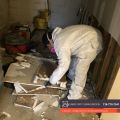Understanding Black Mold: Identification, Risks, and Professional Solutions

Black mold, scientifically known as Stachybotrys chartarum, is one of the most concerning types of mold that can infest a home or building. Due to its potential health risks and the damage it can cause to property, understanding how to identify, prevent, and address black mold is essential. This article provides a comprehensive guide on what black mold looks like, its common sources, where it grows, and why it’s dangerous, along with symptoms of exposure, inspection processes, and a case study demonstrating the importance of professional mold services.
What Does Black Mold Look Like?
Black mold is typically dark green or black and has a slimy or sooty texture when it’s wet. It often appears as clusters of black spots or patches and tends to grow in areas that have been subjected to water damage. The surface may look slightly shiny or slimy due to the moisture content. As it dries, it can become more powdery, but the dark coloration remains.
Common Sources of Black Mold
Black mold primarily thrives in areas that have been exposed to consistent moisture or water damage. Common sources include:
- Leaking Pipes: Slow or unnoticed leaks behind walls or under floors create an ideal environment for black mold.
- Roof Leaks: Water entering through a damaged roof can lead to mold growth in attics or ceiling spaces.
- Flooding: Any area that has been flooded and not properly dried within 24-48 hours is at risk of developing black mold.
- Condensation: Areas with poor ventilation, such as basements or bathrooms, where condensation accumulates on surfaces, are prone to mold growth.
- Damp Building Materials: Materials like drywall, wood, and insulation that have absorbed water can harbor mold if not dried properly.
Where Does Black Mold Grow?
Black mold favors dark, damp, and poorly ventilated environments. It can grow on a variety of surfaces and materials, including:
- Drywall: Especially in areas near plumbing leaks or where water has seeped into the walls.
- Wood: Floors, furniture, or structural beams that have been exposed to moisture.
- Carpets: Especially those that have been soaked or are in basements with high humidity.
- Ceiling Tiles: Particularly those that have been affected by roof leaks or high humidity levels.
- Insulation: Mold can grow within insulation materials that have become wet.
What Causes Black Mold?
The primary cause of black mold is excessive moisture. Contributing factors include:
- Water Leaks: From pipes, roofs, or windows, leaks that are left untreated are a common cause.
- Flooding: Homes that have experienced flooding are at high risk for mold if they are not properly dried.
- High Humidity: Humid climates or poorly ventilated areas can trap moisture, leading to mold growth.
- Condensation: Poor insulation or ventilation can cause condensation, particularly in basements, windowsills, and behind furniture.
Is Black Mold Dangerous?
Yes, black mold is considered dangerous due to the potential health risks associated with exposure. While not all molds are harmful, black mold is known to produce mycotoxins, which can lead to serious health issues, especially with prolonged exposure.
Health Risks Include:
- Respiratory Issues: Chronic coughing, sneezing, and throat irritation.
- Asthma Attacks: Black mold can trigger or worsen asthma symptoms, particularly in children.
- Allergic Reactions: Including rashes, hives, and itching.
- Chronic Fatigue: Prolonged exposure can lead to persistent tiredness.
- Headaches: Frequent and unexplained headaches can be a symptom of black mold exposure.
- Neurological Symptoms: In severe cases, exposure to mycotoxins can cause dizziness, confusion, and even memory loss.
Symptoms of Exposure to Black Mold
If you suspect that you or your family have been exposed to black mold, be alert to the following symptoms:
- Respiratory Problems: Difficulty breathing, persistent coughing, or sneezing.
- Eye Irritation: Red, itchy, or watery eyes.
- Skin Rashes: Unexplained skin irritation, rashes, or hives.
- Nasal Congestion: Persistent or chronic sinus issues, including runny or stuffy nose.
- Fatigue: Unusual and ongoing tiredness that doesn’t improve with rest.
- Headaches: Frequent headaches that may worsen over time.
If these symptoms persist, particularly when spending time indoors, it is advisable to seek medical attention and consider a professional mold inspection.
Black Mold Inspection and Testing Process
When dealing with potential black mold, a thorough inspection and testing process is crucial:
- Initial Inspection: A professional mold inspector will conduct a visual assessment, looking for visible signs of mold and moisture.
- Moisture Mapping: Using moisture meters and infrared cameras, inspectors identify areas of hidden moisture where mold is likely to grow.
- Air Sampling: Air samples are taken from various locations within the home to detect mold spores in the air. This helps identify the presence and concentration of black mold.
- Surface Sampling: Swabs or tape lifts may be taken from suspected areas to confirm the type of mold.
- Laboratory Analysis: Samples are sent to a laboratory for analysis to identify the species of mold and its potential toxicity.
- Report and Recommendations: The inspector provides a detailed report of the findings along with recommendations for remediation if black mold is detected.
Case Study: Successful Black Mold Remediation in a San Mateo Home
Background
A family in San Mateo began experiencing unexplained health issues, including persistent coughs and fatigue. Suspecting mold, they contacted Bay Area Mold Pros for an inspection.
Inspection
Certified inspector Rick Bruce conducted a thorough inspection, including air and surface sampling. Black mold was discovered behind the drywall in the basement, where a hidden leak had gone unnoticed for months.
Remediation
The Bay Area Mold Pros team developed a customized remediation plan, which included removing the affected drywall, repairing the leak, and treating the area with antimicrobial solutions. After remediation, a follow-up inspection confirmed the complete removal of the mold.
Outcome
The family’s health improved significantly after the mold was removed, and preventive measures were put in place to avoid future issues.
Professional Mold Inspection and Testing Services by Bay Area Mold Pros
Dealing with black mold requires expertise and precision. Bay Area Mold Pros offers comprehensive mold inspection and mold testing services to ensure your home is safe and mold-free.
Why Choose Bay Area Mold Pros?
- Certified Experts: Led by certified mold inspector Rick Bruce, the team has extensive experience in identifying and remediating mold problems.
- Advanced Technology: The use of state-of-the-art equipment ensures accurate detection of hidden mold.
- Detailed Reporting: Clients receive thorough reports with actionable recommendations for remediation.
- Comprehensive Services: From inspection to remediation and follow-up testing, Bay Area Mold Pros handles every aspect of mold management.
For professional mold inspection and testing services, contact Bay Area Mold Pros at (650) 762-6228 or visit Bayareamoldpros.com to request an inspection.







